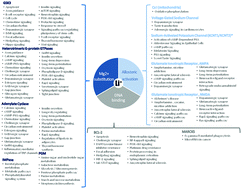当前位置:
X-MOL 学术
›
Metallomics
›
论文详情
Our official English website, www.x-mol.net, welcomes your feedback! (Note: you will need to create a separate account there.)
From direct to indirect lithium targets: a comprehensive review of omics data
Metallomics ( IF 3.4 ) Pub Date : 2017-08-30 00:00:00 , DOI: 10.1039/c7mt00203c Magali Roux 1, 2, 3 , Anthony Dosseto 4, 5, 6, 7, 8
Metallomics ( IF 3.4 ) Pub Date : 2017-08-30 00:00:00 , DOI: 10.1039/c7mt00203c Magali Roux 1, 2, 3 , Anthony Dosseto 4, 5, 6, 7, 8
Affiliation

|
Metal ions are critical to a wide range of biological processes. Among them, lithium (Li) has been recognised for its benefit as a treatment for bipolar disorder (BD). However, we are yet to grasp the extent of its role in biological processes, despite its molecular targets having been extensively studied. Here we review a wide range of transcriptomic, proteomic and metabolomic studies in order to obtain a full picture of Li effects at various levels. Multifarious patterns of Li-regulated genes, proteins and metabolites are identified. Some of these patterns are explained as the outcomes of individual Li targets. For instance, Li inhibition of GSK-3 has a wide range of effects: axis development in embryos; cell and tissue differentiation, in particular neurogenesis and osteogenesis; or control of apoptosis. This results in neuroprotection and an attenuation of cognitive deficits. Lithium plays an important role in mitochondrial function, which it improves via its role in phospholipid metabolism and inositol depletion. This is also seen in metabolomics, where its role in the mitochondrial respiratory chain influences energy production and oxidative stress. Lithium also affects the proteins involved in the processing of APP, thus highlighting a possible involvement in Alzheimer's disease. Finally, Li also impacts lipid homeostasis, with studies showing that environmental exposure can impact lipid transport and prostaglandin synthesis. It is seldom possible to establish a causal relationship between Li targets at the molecular level and the resulting effects at the system level. For example, Li effects on adenylate cyclase regulation are not easily linked to any omic pattern despite the importance of the adenylate pathway. Nevertheless, refining our knowledge on the cellular functions of individual Li targets would improve our understanding and interpretation of omics data. This review demonstrates that Li is key to a wide range of processes at all levels, from neuroprotection to oxidative stress and energy production. A corollary of this work is the need for an increased awareness of environmental issues related to Li industrial wastes, in particular considering the widespread use of this metal in our modern society.
中文翻译:

从直接锂目标到间接锂目标:组学数据的全面回顾
金属离子对于广泛的生物过程至关重要。其中,锂(Li)因其作为双相情感障碍(BD)的治疗方法而受益。然而,尽管已经对其分子靶标进行了广泛研究,但我们仍未掌握其在生物过程中的作用范围。在这里,我们回顾了广泛的转录组学,蛋白质组学和代谢组学研究,以全面了解锂在不同水平上的作用。鉴定出Li调节基因,蛋白质和代谢产物的多种模式。其中一些模式被解释为单个Li目标的结果。例如,Li对GSK-3的抑制作用具有广泛的作用:胚胎轴的发育;细胞和组织分化,特别是神经发生和成骨;或控制细胞凋亡。这导致神经保护和认知缺陷的减轻。锂在线粒体功能中起着重要作用,它可以改善通过其在磷脂代谢和肌醇消耗中的作用。在代谢组学中也可以看到这一点,在代谢组学中,其在线粒体呼吸链中的作用会影响能量产生和氧化应激。锂还影响参与APP加工的蛋白质,从而突显出可能参与了阿尔茨海默氏病。最后,李还影响脂质体内平衡,研究表明环境暴露可影响脂质转运和前列腺素合成。几乎不可能在分子水平的Li靶标与系统水平的结果之间建立因果关系。例如,尽管腺苷酸途径的重要性,但Li对腺苷酸环化酶调控的影响并不容易与任何组学模式联系起来。尽管如此,完善我们对单个Li靶标的细胞功能的认识将改善我们对组学数据的理解和解释。这项审查表明,锂是从神经保护到氧化应激和能量产生的各个过程的关键。这项工作的必然结果是需要提高对与锂工业废料有关的环境问题的认识,尤其是考虑到这种金属在现代社会中的广泛使用。
更新日期:2017-09-08
中文翻译:

从直接锂目标到间接锂目标:组学数据的全面回顾
金属离子对于广泛的生物过程至关重要。其中,锂(Li)因其作为双相情感障碍(BD)的治疗方法而受益。然而,尽管已经对其分子靶标进行了广泛研究,但我们仍未掌握其在生物过程中的作用范围。在这里,我们回顾了广泛的转录组学,蛋白质组学和代谢组学研究,以全面了解锂在不同水平上的作用。鉴定出Li调节基因,蛋白质和代谢产物的多种模式。其中一些模式被解释为单个Li目标的结果。例如,Li对GSK-3的抑制作用具有广泛的作用:胚胎轴的发育;细胞和组织分化,特别是神经发生和成骨;或控制细胞凋亡。这导致神经保护和认知缺陷的减轻。锂在线粒体功能中起着重要作用,它可以改善通过其在磷脂代谢和肌醇消耗中的作用。在代谢组学中也可以看到这一点,在代谢组学中,其在线粒体呼吸链中的作用会影响能量产生和氧化应激。锂还影响参与APP加工的蛋白质,从而突显出可能参与了阿尔茨海默氏病。最后,李还影响脂质体内平衡,研究表明环境暴露可影响脂质转运和前列腺素合成。几乎不可能在分子水平的Li靶标与系统水平的结果之间建立因果关系。例如,尽管腺苷酸途径的重要性,但Li对腺苷酸环化酶调控的影响并不容易与任何组学模式联系起来。尽管如此,完善我们对单个Li靶标的细胞功能的认识将改善我们对组学数据的理解和解释。这项审查表明,锂是从神经保护到氧化应激和能量产生的各个过程的关键。这项工作的必然结果是需要提高对与锂工业废料有关的环境问题的认识,尤其是考虑到这种金属在现代社会中的广泛使用。



























 京公网安备 11010802027423号
京公网安备 11010802027423号